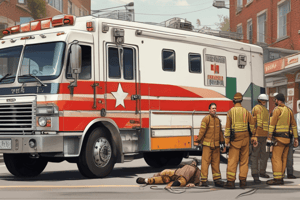Podcast
Questions and Answers
What is the primary goal of triage in emergency situations?
What is the primary goal of triage in emergency situations?
- To ensure all patients receive immediate treatment
- To minimize the use of medical resources
- To prioritize patients based on age
- To deliver patients to definitive care quickly and safely (correct)
Which triage scale uses a color-coding system that includes black, red, yellow, and green?
Which triage scale uses a color-coding system that includes black, red, yellow, and green?
- Australian Triage Scale
- START Triage (correct)
- Manchester Triage Scale
- Canadian Emergency Department Triage and Acuity Scale
What is the purpose of extraordinary triage?
What is the purpose of extraordinary triage?
- To speed up the decision-making for individual patients
- To ensure that all patients are seen within one hour
- To treat all patients equally regardless of injury severity
- To manage triage during mass casualty incidents (correct)
Which of the following is NOT a kind of triage mentioned?
Which of the following is NOT a kind of triage mentioned?
Which triage scenario is characterized by extraordinary triage methods?
Which triage scenario is characterized by extraordinary triage methods?
What is a primary feature of ordinary triage when compared to extraordinary triage?
What is a primary feature of ordinary triage when compared to extraordinary triage?
Which of the following scenarios would require extraordinary triage?
Which of the following scenarios would require extraordinary triage?
What characteristic defines a patient classified with a green triage level in the START system?
What characteristic defines a patient classified with a green triage level in the START system?
In the context of emergency medicine, what is the ultimate goal of triage?
In the context of emergency medicine, what is the ultimate goal of triage?
Which triage scale is most closely associated with incident types like natural disasters or terror attacks?
Which triage scale is most closely associated with incident types like natural disasters or terror attacks?
What assessment criteria must be met for a patient to be classified as yellow in START triage?
What assessment criteria must be met for a patient to be classified as yellow in START triage?
Flashcards are hidden until you start studying
Study Notes
Triage Overview
- Triage is a process used to prioritize patient care based on the severity of their condition and the resources available.
- Two main types of triage: Ordinary Triage and Extraordinary Triage.
Ordinary Triage
- Involves standard assessment methods for patients.
- Common systems include:
- Emergency Severity Index (ESI)
- Australian Triage Scale
- Canadian Emergency Department Triage and Acuity Scale
- Manchester Triage Scale
- Soterion Rapid Triage Scale
- Aims to efficiently match patient acuity with the appropriate medical resources.
- Fast track areas allow quicker processing of less critical patients while maintaining main treatment areas for severe cases.
Extraordinary Triage
- Activated during significant emergencies, such as mass casualty incidents.
- Critical events involve:
- Natural disasters (e.g., hurricanes, earthquakes)
- Terror attacks
- Multiple vehicle crashes
- HAZMAT (Hazardous Materials) releases
- Prioritizes care in situations with overwhelming numbers of patients needing immediate attention.
Triage Goals
- Key objective: "Do the most good for the most patients."
- Ensure quick and safe delivery of patients to definitive care.
- START (Simple Triage And Rapid Transport) method is used for emergency situations.
START Triage Levels
- Black: Deceased or severely injured – no chance of survival.
- Red: Immediate transport needed – life-threatening conditions requiring prompt care.
- Yellow: Delayed transport – serious but not life-threatening.
- Green: Minor injuries – walking wounded, can wait for care.
START Triage Simplified
- Remember key indicators: 30 and 2, Can Do.
- Patients can be classified as Green if they can walk and have reliable signs of stability.
- Yellow classification applies if the following conditions are met:
- Respiratory Rate (RR) < 30
- Capillary refill time indicates reasonable circulation.
Triage Overview
- Triage is a process used to prioritize patient care based on the severity of their condition and the resources available.
- Two main types of triage: Ordinary Triage and Extraordinary Triage.
Ordinary Triage
- Involves standard assessment methods for patients.
- Common systems include:
- Emergency Severity Index (ESI)
- Australian Triage Scale
- Canadian Emergency Department Triage and Acuity Scale
- Manchester Triage Scale
- Soterion Rapid Triage Scale
- Aims to efficiently match patient acuity with the appropriate medical resources.
- Fast track areas allow quicker processing of less critical patients while maintaining main treatment areas for severe cases.
Extraordinary Triage
- Activated during significant emergencies, such as mass casualty incidents.
- Critical events involve:
- Natural disasters (e.g., hurricanes, earthquakes)
- Terror attacks
- Multiple vehicle crashes
- HAZMAT (Hazardous Materials) releases
- Prioritizes care in situations with overwhelming numbers of patients needing immediate attention.
Triage Goals
- Key objective: "Do the most good for the most patients."
- Ensure quick and safe delivery of patients to definitive care.
- START (Simple Triage And Rapid Transport) method is used for emergency situations.
START Triage Levels
- Black: Deceased or severely injured – no chance of survival.
- Red: Immediate transport needed – life-threatening conditions requiring prompt care.
- Yellow: Delayed transport – serious but not life-threatening.
- Green: Minor injuries – walking wounded, can wait for care.
START Triage Simplified
- Remember key indicators: 30 and 2, Can Do.
- Patients can be classified as Green if they can walk and have reliable signs of stability.
- Yellow classification applies if the following conditions are met:
- Respiratory Rate (RR) < 30
- Capillary refill time indicates reasonable circulation.
Studying That Suits You
Use AI to generate personalized quizzes and flashcards to suit your learning preferences.




